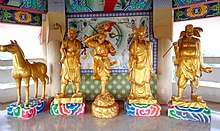White Dragon Horse
The White Dragon Horse, known as Bai Longma (Chinese: 白龍馬) in Chinese, is one of the main characters in the 16th-century Chinese novel Journey to the West.[1] He is Tang Sanzang's steed who later became Babu Tianlong Guangli Bodhisattva (八部天龙广力菩萨) at the end of novel.[2][3]

Journey to the West
In Journey to the West, Bai Longma is actually a dragon prince Ao Lie who is the third son of the Dragon King of the West Sea. He once set a fire that destroyed a pearl that was a gift from the Jade Emperor. He was about to be executed for committing this offense when Guanyin appeared and pleaded for his life. The dragon prince was spared from death and banished to Yingchou Stream (鷹愁澗) in Shepan Mountain (蛇盤山).[4][5] When Tang Sanzang is crossing the stream, the prince appears in the form of a gigantic white dragon and swallows Tang's white horse in one gulp. The dragon then fights with Sun Wukong but is no match and retreats underwater. Sun Wukong hears from an Earth Deity that the dragon was placed there by Guanyin so he goes to find the bodhisattva and learns of the dragon's origin. The dragon prince had been waiting there for Tang Sanzang but did not recognise the latter and ate his horse as a result. The dragon then transforms into the White Dragon Horse and serves as Tang Sanzang's steed for the rest of the latter's journey.[6]
When Tang Sanzang was captured by the Yellow Robe Demon, the White Dragon Horse transforms himself a young man and attempts to save Tang Sanzang, but fails and he escapes to inform Zhu Bajie, who in turn brings back Sun Wukong to save Tang Sanzang.[7]
At the end of the novel, the White Dragon Horse is ordained as the Great Strength Bodhisattva of the Eight Heavenly Sections (八部天龙广力菩萨) and Dragon Horse of the Eight Heavenly Sections (八部天龍馬). He turns into a white dragon and wraps his body around one of the pillars in the Great Leiyin Temple.[8]
Religion

Bai Longma is worshipped as a deity in Chinese folk religion. Located in Rua Yai, Mueang Suphan Buri District, Suphan Buri, Thailand, the City Pillar Shrine (ศาลเจ้าพ่อหลักเมืองสุพรรณบุรี) has built a golden statue of Bai Longma, along with Tang Sanzang, Sun Wukong, Zhu Bajie and Sha Wujing.[9]
Adaptations of Journey to the West
In the 1986 television series, the White Dragon Horse was getting married when her fiancee, the Wansheng Princess was cheating on him. He got so angry that he burned the pearl given to him as a gift by the Jade Emperor and was banished to Yingchou Stream by the Jade Emperor as punishment. Sometime after being punished, the White Dragon Horse ate Tang Sanzang's horse when the horse ran off. When Sun Wukong saw that the horse was missing, he fought the dragon prince demanding his master's horse back. After fighting with the prince, Wukong went to the Dragon King's palace to discuss with the dragon he fought. When Guanyin appeared, Sun Wukong told her about the dragon that ate his master's horse. Guanyin called the prince out and instructed him to be Tang Sanzang's steed for the rest of the journey.
References
- "蔡詩萍/花甲美魔男之「爸話西遊」之十一". Yahoo! News (in Chinese). 2 December 2019.
- 西遊記: Journey to the West (in Chinese). Google Publishing. 2014.
- Fair, Collinson; Cheng-en, Wu (2005). The Journey to the West. Silk Pagoda. ISBN 978-1-59654-251-8.
- Amos, Yukari Takimoto; Amos, Daniel Miles (2018). Children’s Literature from Asia in Today’s Classrooms: Towards Culturally Authentic Interpretations. Rowman & Littlefield. ISBN 978-1-4758-4369-9.
- Zhang, Yuyan; Feng, Weijiang (2018). Peaceful Development Path in China. Springer. ISBN 978-981-13-1439-1.
- Cheng-En, Wu (14 May 2013). "Journey to the West - Chinese" (in Chinese). Lulu.com.
- "休息的时候,白龙马为啥不变回人形?原来是这么回事!_手机搜狐网". Sohu. 26 June 2019.
- "小白龙被封为八部天龙广力菩萨, 这是多大的官? 负责什么工作". Sina (in Chinese). 22 December 2017.
- "เชียงใหม่, สมุทรสงคราม, สุราษฎร์ธานี (ตอนที่4)". BlogGang.com.
Sources
- "季羡林说出了,白龙马的真实身份,原来唐僧骑的是蛇 - 快资讯". 快资讯 (in Chinese). 25 November 2019.
- ""小白龙"的八部天龙广力菩萨究竟是什么玩意?八部天龙有哪些?". 一点资讯 (in Chinese). 6 March 2019.
- "兰州白马浪,是西游记历史和小说世界的碰撞地方". 每日头条 (in Chinese). 9 March 2018.